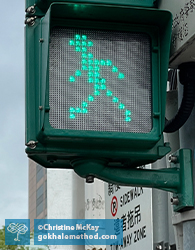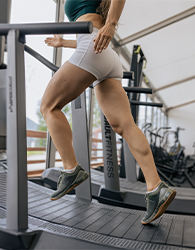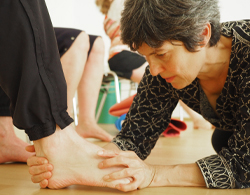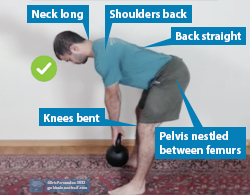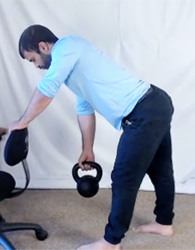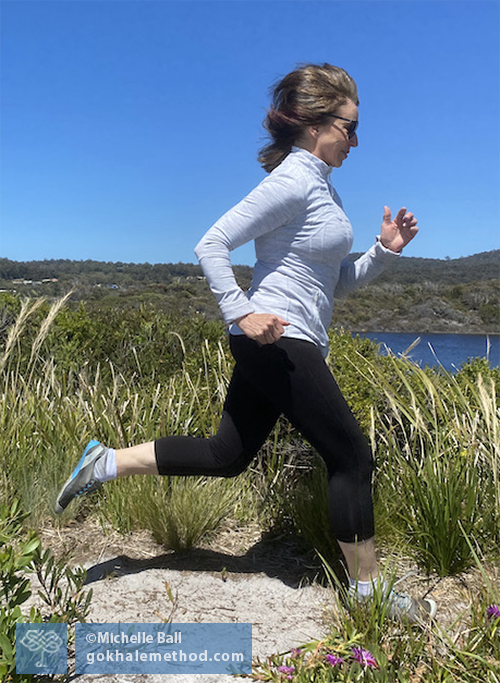The best art often communicates on many levels. The Walking Men 99™ exhibit is a great example. It consisted of a frieze of pedestrian crossing icons, photographed and assembled from around the world. At human scale, they mingled with passersby on the sidewalk.
Treadmill Training with Healthy Posture
During the Victorian Era, a British engineer, William Cubitt, invented the treadmill as a means of harnessing hard labor in prisons and penal colonies. It was also used unproductively, purely as a punitive measure. Despite this sordid history, the treadmill has become a highly beneficial and enjoyable device within the context of a contemporary lifestyle.
The sedentary nature of modern life in the industrialized world leaves most of us with less than the ideal amount of physical activity. In 1968 the importance of aerobic exercise was popularized by the book Aerobics by Kenneth H. Cooper. Inspired by this book, the first electric consumer treadmill was developed by another American by the name of William Edward Staub.
Fixing Plantar Fasciitis
Why is it not a routine practice for podiatrists to observe their plantar fasciitis patients’ stance and gait? Let’s consider how a broader approach that considers the way people stand and walk could improve treatment outcomes for plantar fasciitis patients—and also help prevent recurrences.
How To Go Down Stairs (Part 2)
Welcome to our second post on navigating steps and stairs. Our first post looked at how to power yourself up stairs—however, we often hear from our students that their most pressing concern is how to come down stairs.
Are you starting to worry that you may need to set up your bedroom downstairs, or find yourself compromised when visiting places with stairs? Perhaps you have a friend or older relative in this position? Is it possible to maintain or even improve your fitness and mobility in the years ahead? “Life exercises” such as descending stairs, done skilfully, can be transformative and can give many benefits beyond getting you where you want to go.
The New Year 3 x 3 Fitness Challenge: Strength without Strain
We’re here to help with your New Year’s fitness resolution. Join us for a FREE 10-day New Year 3 x 3 Fitness Challenge, which is offered as part of the Gokhale Exercise program. It will be fun, safe, and effective, enabling you to build your strength without strain and injury, because, all the while, you are also training for healthy posture!
The Best Way to Strengthen a Muscle
Using the word “eccentric” might sound like I’m about to write about muscles behaving in weird ways that are different from usual muscle behavior!
But what I’m referring to, eccentric muscle contraction, is often pronounced ee-sen-trik, not ek-sen-trik.
How muscles contract
Eccentric muscle contraction is the reverse of the concentric contraction that we typically associate with muscle training. For example, the dumbbell curl that makespops up the bicep prominent as you lift the weight towards your shoulder is a concentric contraction. The muscle contracts and shortens. But lowering the dumbbell back down again, which requires the muscle to lengthen, also takes
Gliderunning: Part 3: How to choose running shoes
Welcome to the third blog post in our series on running. My name is Michelle Ball, and I am a Gokhale Method® teacher in Tasmania. I am a lifelong runner and am passionate about sharing my experience with beginners as well as seasoned runners and everyone in between. Even if you don’t run, but do wear shoes, this blog post is for you!
Active feet come first
When it comes to advice about running, our feet often get sidelined by the subject of shoes. If you missed Part 2, which is about how to build healthy, active feet, we recommend you catch up here.
Gliderunning: Part 2: Meet Your Feet
Welcome to the second blog post in our series on running. This series is designed to be useful to beginners and would-be beginners, as well as seasoned runners and everyone in between. If you missed Part 1, you can catch up here.
Reactivate your feet
When it comes to advice about running, the feet often get overlooked as the subject immediately turns to shoes. While shoes are an important subject (spoiler alert! Part 3 is about shoes), I prefer to start with that miracle of bioengineering that actually does the work—your feet.
Our feet become very passive from walking on flat, featureless surfaces rather than natural, more undulating terrain. They are also constrained, misshapen and deconditioned by less-than-ideal footwear, which, sadly, includes many running shoes on the market.
Feet Out or Straight Ahead?
When it comes to foot position, feet parallel is often regarded as the ideal in our present-day culture. Standing with the feet apart, pointing straight ahead, is also seen as the starting point of a normal and healthy gait. Walking then proceeds along two parallel lines, like being on railway tracks.
From a Gokhale Method® perspective, a healthy baseline position for the feet is angled outward 5–15°, or “externally rotated.” Why is there such divergence of opinion—and angle?
Most people learn and then teach feet straight ahead
Feet straight ahead is the model learned and perpetuated by most professionals who are trained in anatomy, whether they are fitness coaches, yoga teachers, Pilates instructors, physical therapists, podiatrists, family physicians, or surgeons. Training regimens, gait analysis, shoe design, and equipment such as elliptical trainers and step machines are also based on this belief.
Are Muscle Imbalances and Asymmetry Causing My Back Pain?
Many of the questions I hear from students are about concerns they have due to left/right asymmetry in their bodies. People will often see a clearly visible asymmetry as the root cause of any dysfunction and pain. This strikes me as a natural and understandable assumption—but my experience as a posture educator leads me to think there is more to consider here than meets the eye.

